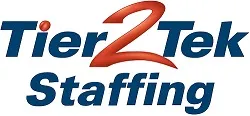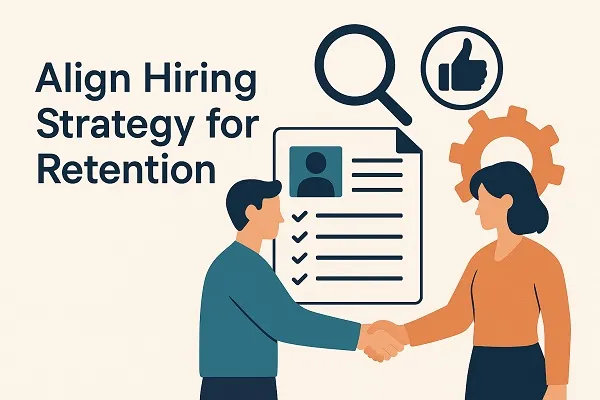How you align your hiring strategy for retention can make the difference between a thriving, stable team and a revolving door of talent. Organizations often focus heavily on acquiring the best talent—but if that talent leaves after six months, the cycle becomes costly and disruptive. Retention must be embedded in every stage of the hiring process.
Hiring with retention in mind doesn’t just fill roles; it strengthens long-term culture, engagement, and business performance. Let’s break down how to structure your hiring strategy to support long-term retention.
Understand What Drives Retention in Your Organization
Before refining your hiring strategy, it’s essential to know why employees stay. Retention isn’t a one-size-fits-all metric—it varies by company, industry, and even department.
Here’s how to uncover your own retention drivers:
- Conduct stay interviews: Talk to current long-tenured employees to understand what keeps them motivated.
- Analyze exit interviews: Identify patterns in why employees leave.
- Review engagement surveys: Look for trends in satisfaction, workload, career development, and manager support.
- Benchmark roles with high vs. low turnover: Compare environments, onboarding practices, and team dynamics.
This data helps tailor your hiring approach based on what works within your unique company culture.
Define What “Retention-Friendly” Talent Looks Like
Once you understand the reasons people stay, it’s easier to identify candidates who are more likely to thrive and remain with the company long-term.
Characteristics to Look For:
- Cultural alignment: Values that match your organizational ethos.
- Adaptability: Ability to grow as the company evolves.
- Interest in development: Desire for long-term career growth.
- Realistic expectations: Awareness of role challenges and company pace.
This doesn’t mean you should only hire people who “fit in”—but they should resonate with your mission and growth path.
Refine Job Descriptions to Reflect Reality

Clear, transparent job descriptions play a major role in reducing early turnover. Misalignment between what’s promised and what’s delivered leads to fast exits.
Tips to Improve Job Descriptions:
- Be honest about the day-to-day responsibilities—don’t oversell.
- Include team structure and who the role reports to.
- Mention career development opportunities and learning support.
- Share company values and what success looks like in the first 6–12 months.
Authenticity in job postings attracts candidates who know what they’re signing up for—and are more likely to stay.
Build a Hiring Process That Screens for Long-Term Fit
Hiring with retention in mind means going beyond resumes and technical qualifications. You need to assess soft skills, attitude, and alignment with team dynamics.
Strategies to Incorporate:
- Behavioral interviews: Ask questions that reveal past patterns, such as:
- “Tell me about a time you stayed in a role longer than you initially planned.”
- “What does growth mean to you?”
- “Why did you leave your last few roles?”
- Culture interviews: Include team members in interviews to assess interpersonal fit.
- Realistic job previews: Give candidates a feel for what a typical day looks like or offer trial projects.
- Structured evaluation criteria: Use scorecards that include “retention indicators” such as coachability, motivation, and cultural alignment.
Invest in Onboarding That Reinforces Retention
The hiring process doesn’t end with an offer letter. Onboarding is the bridge between a new hire’s expectations and their actual experience. A strong start significantly increases the chance they’ll stay.
Elements of Retention-Focused Onboarding:
- Clear 30-60-90 day plans
- Regular one-on-ones with managers
- Early exposure to team culture and values
- Mentorship or buddy programs
- Transparent feedback loops
When new hires feel supported and connected, they’re more likely to invest in their role long-term.
Align Hiring Metrics With Retention Goals

Traditional hiring metrics—like time-to-fill and offer acceptance rate—only tell part of the story. To align with retention, your recruiting KPIs should track outcomes over time.
Recommended Metrics:
1. New Hire Turnover Rate
- Measures the percentage of employees who leave within a specific period (e.g., 3, 6, or 12 months).
- Indicates whether hiring and onboarding processes are setting the right expectations.
2. Quality of Hire
- Combines performance ratings, engagement scores, and retention status.
- Typically assessed at 6 and 12 months post-hire.
3. Time to Productivity
- Measures how long it takes a new employee to become fully productive.
- Shorter time may indicate effective hiring and onboarding.
4. First-Year Retention Rate
- Tracks the percentage of new hires who stay for at least one year.
- A key signal of early employee satisfaction and fit.
5. Hiring Source Retention Rate
- Compares retention based on different sourcing channels (e.g., job boards, referrals, recruiters).
- Helps optimize sourcing strategies for longevity.
6. Manager Satisfaction Score
- Gathers hiring manager feedback on how well a new hire meets expectations.
- Often collected 90 days and 6 months post-hire.
7. Candidate Net Promoter Score (cNPS)
- Asks candidates how likely they are to recommend your company based on the hiring experience.
- A strong predictor of employer brand health and future talent pipeline.
8. Interview-to-Hire Ratio
- Tracks how many candidates are interviewed for each successful hire.
- A high ratio may signal inefficiencies or misalignment on candidate quality.
9. Offer Acceptance Rate
- Measures the percentage of job offers accepted.
- A low rate could signal issues with compensation, brand perception, or recruiter communication.
10. Internal Mobility Rate
- Percentage of roles filled by existing employees.
- Indicates internal career growth and contributes directly to retention.
11. Cost Per Hire (with Retention Context)
- Calculate hiring cost not just in terms of dollars, but relative to the tenure and performance of the hire.
12. Tenure by Role or Department
- Helps identify which teams or job functions have the strongest or weakest retention.
13. Employee Lifetime Value (ELTV)
- Estimates the net value an employee brings to the company over their tenure.
- Higher ELTV from new hires indicates more effective hiring decisions.
14. Percentage of High-Performers Retained
- Tracks whether your hiring process is bringing in top talent that stays and performs well.
15. New Hire Engagement Score
- Measures how engaged new employees feel during their first 90–180 days.
- Often gathered via pulse surveys.
16. Ramp-Up Time
- Similar to time to productivity, this focuses on how long it takes new hires to reach specific KPIs or goals.
17. Onboarding Satisfaction Score
- Captures feedback from new hires about their onboarding experience.
- Poor onboarding can directly impact early attrition.
18. Pre-Hire Assessment Accuracy
- Compares predictions from pre-employment tests with actual performance and tenure.
- Helps fine-tune screening tools for better long-term fit.
19. Voluntary vs. Involuntary Turnover in First Year
- Breaks down early exits to determine whether hiring issues or performance problems are the main cause.
20. Employee Referral Retention Rate
- Tracks how long referred hires stay compared to other sources.
- Referrals often result in better cultural alignment and longer tenure.
These insights help you continuously improve hiring practices with retention as the North Star.
Collaborate Across Teams for Better Hiring Outcomes

Retention isn’t just HR’s responsibility. Hiring managers, team leads, and even existing employees play a role in shaping how well a new hire sticks.
Encourage cross-functional alignment on:
- What a successful hire looks like
- Shared responsibility for onboarding
- Ongoing feedback mechanisms
- Internal mobility and development plans
When everyone contributes to the success of a new employee, retention becomes a company-wide strength.
Prioritize Internal Mobility and Career Pathing During Recruitment
Candidates want to see a future with your company. If you can show a clear growth trajectory from the start, they’re more likely to stay and invest in your mission.
During the hiring process, highlight:
- How employees have progressed internally
- Access to learning and development resources
- Opportunities to switch roles or departments over time
- How promotions are structured and communicated
This helps candidates imagine not just joining your company—but growing with it.
Tailor Hiring Strategy to Different Roles
Retention risks differ across job levels, functions, and locations. A retention-oriented hiring strategy should adapt accordingly.
Examples:
- Entry-level roles: Emphasize mentorship and structured growth paths.
- Senior roles: Focus on leadership autonomy, vision alignment, and organizational impact.
- Remote roles: Prioritize communication style, self-motivation, and digital collaboration skills.
Customizing your hiring approach improves fit—and reduces the chance of early attrition.
Don’t Ignore Employer Brand and Candidate Experience

Candidates form impressions long before the interview. A strong employer brand that reflects your values, culture, and retention success stories attracts more qualified and aligned applicants.
Ways to enhance your employer brand:
- Share employee testimonials on your career site
- Highlight team longevity and development stories
- Ensure consistency across job boards, social media, and internal messaging
- Offer a smooth, respectful interview experience with timely feedback
When your brand reflects reality, the right candidates come with a longer-term mindset.
Hiring is no longer just about filling seats—it’s about building sustainable teams. When your hiring strategy is intentionally aligned with retention goals, every step of the process contributes to long-term engagement, loyalty, and growth. By understanding what drives your employees to stay and weaving those insights into recruiting, onboarding, and employer branding, you create a hiring strategy that doesn’t just attract—but retains top talent.
Let retention guide your next hire—and watch the compounding benefits unfold.
Content reviewed and published by Tier2Tek Staffing Editorial Team .

